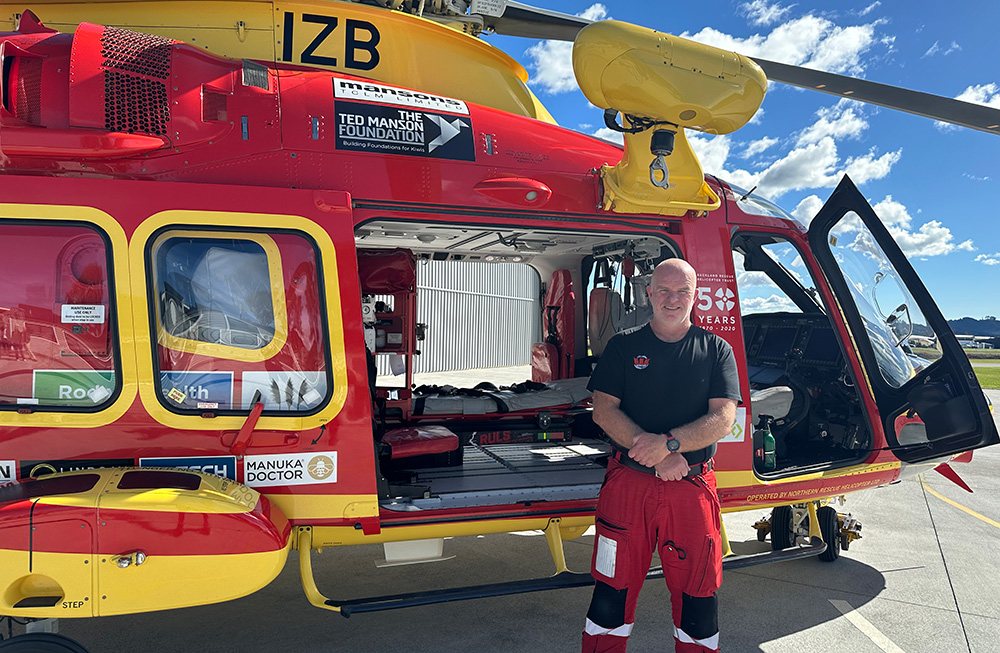
Mark Cannell
With forests covering more than a third of New Zealand, bush survival skills are a must for GA pilots and crews, says search and rescue veteran Mark Cannell.
Mark, an air crew officer and winch operator with Northern Rescue Helicopters, says he has a healthy respect for the ability of our forests to “make an aircraft disappear”.
“An aircraft can hit at an angle and the bush can fold up over the top of it, so the aircraft disappears from view. You’re dealing with 4000 pounds of weight, and yet you might see a branch that’s broken, and that’s all.”
Show signs of life
Mark has become hyper-attuned to looking out for tell-tale signs of life, and he has ideas for what you can do if you’re looking to attract the attention of aircraft overhead.
“Sometimes people don’t have flares, torches, or devices to attract attention. But if the area is lightly wooded, is there a tree you can shake? Seeing a tree doing the crazy boogie will get our attention. If we see something with a bit of colour and contrast, some movement or an unusual shape, that will attract our attention too – for example, a survival blanket torn into strips and hanging in a tree. I’ve known people to turn silver ferns upside down in the creek bed.”
Mark, who has more than 30 years’ search and rescue (SAR) experience – including in New Zealand, Antarctica, and East Timor – says people need to recognise when they’re lost.
“It takes mental strength to accept that you’re lost. I’ve seen people press on because they don’t want their family back at home to worry.
“Next thing, they take a tumble, and get cold and confused. They find themselves on the wrong side of hypothermia. The situation goes from being lost to a full-on medical emergency.”
Be mentally prepared
Those who do the right thing when they get into a bad situation have often done some mental preparedness before their trip.
“Over the years I’ve seen that, in similar settings, some people survived and some didn’t. The survivors had thought about what they might be faced with, so they were mentally prepared.”
He says New Zealand’s changeable weather is a crucial consideration.
“Mother Nature has been doing what she’s been doing for millions of years. People need to realise they won’t get a break from Mother Nature no matter what. So do the right thing by yourself and your family, and prepare.”

Mark Cannell has seen his share of successful rescues, but also catastrophic events with multiple fatalities. He says pilots won’t get a break from Mother Nature and they need to prepare. Photo courtesy of Auckland Rescue Helicopter Trust.
Locator technology is vital kit
Mark is a massive advocate for emergency locator transmitters (ELTs) and personal locator beacons (PLBs) as an integral part of pilots’ survival kits.
“Think about your ELT and your ability to turn it on as part of a developing emergency. Quite often, the beacon is not turned on until quite late in the piece. That can cause some issues including delayed detection and response, which can slow down SAR operations. There have also been cases where the ELT aerial has broken. So having a PLB as your own standalone system can be a very effective survival aid.”
He stresses, though, that they’re of limited use unless you register them. “It costs you nothing to register them, but it can be a significant point of difference for a rescue crew.
“A registered PLB gives SAR authorities quick access to your emergency contacts, enabling a quicker and more efficient response. It also helps SAR to quickly identify false alarms.” - go to beacons.org.nz(external link)
“If they’re not registered, SAR crews are going to a device in the bush and they don’t know what’s at the other end because they don’t have those key details.”
Emotional effects are common
Mark has seen his share of successful rescues, but also catastrophic events with multiple fatalities. These include separate incidents involving two charter vessels with the loss of 13 lives in recent years in the upper North Island.
“During the rescue you’re focused on stopping people dying. But in the aftermath, with the media follow-up, you get a clearer view of who the people were. Fathers, sons, daughters, husbands, wives. It resonates more after the fact. It definitely sits there. It won’t be front of mind forever, but it never completely leaves you.
“And it can be difficult to recognise this within yourself. So we have debriefings, peer support, external expertise. Sometimes we have mandated debriefings for teams and individuals.
“It makes you more aware of the nuances around vulnerability. If I canvassed our team, for example, we would have above average ownership of PLBs and survival gear for our outdoor hobbies and interests. And there are places on State Highway 2 where I pay extra attention to the road because I’ve attended multiple fatalities over the years. You’re more aware.”
And while search and rescue has been revolutionised by things like thermal imaging, twin-engine aircraft, better fuel capacity, and more full-time crew, there are still some basic things people can do to improve their chances of survival when things go wrong.
Mark’s top tips
Whether you’re flying, or going out tramping or hunting, Mark recommends the following actions.
- Before you go, let people know where you’re going, and when you expect to return.
- Carry a basic first aid kit, including items to stop a bleed.
- Carry a PLB, two torches, and a fully-charged cellphone in a waterproof case.
- Carry clothing that you can layer up and down, including windproof gear.
- Take plenty of water.
- If you have an accident or get lost, stay where you are.
And for those who are at home waiting for their mates or family to return, Mark’s advice is clear. Know their route and expected arrival time, then use your common sense if they’re overdue.
“If someone’s not back on time, I’m not clock-watching, but I’ll flick out a text or call to see how they’re tracking. There’s a difference if a 16-year-old is late versus someone who has been hunting for 30 years and has a track record of being a half-hour late.
“If you’re concerned that someone’s not back when they should be, call the police. They will coordinate with SAR teams and other emergency services,” says Mark.
Further reading
GAP Booklet: Survival [PDF 1.8 MB]
Vector Online: Be ready for the emergency
Footnote
Main photo: iStock.com/MollyNZ
